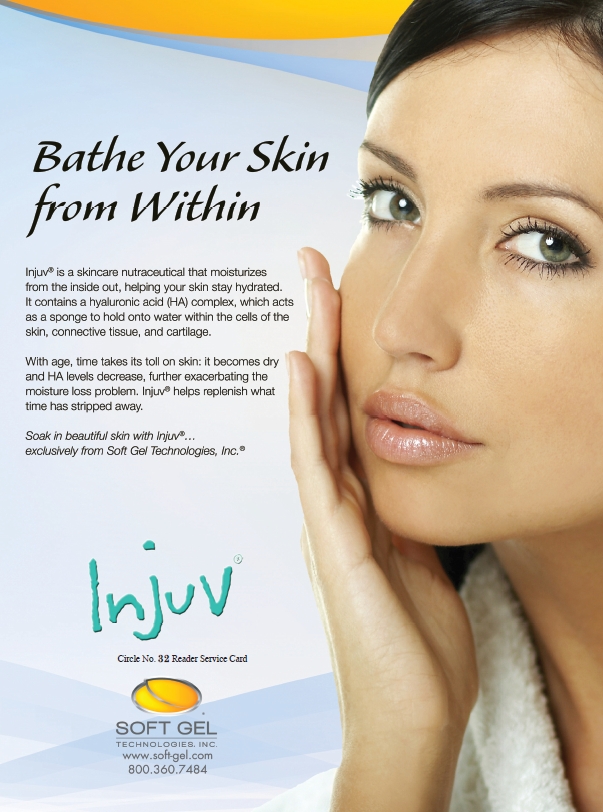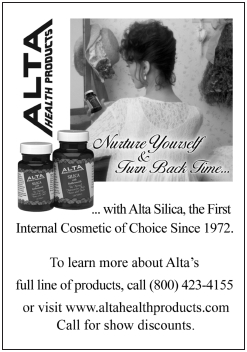When it comes to beauty, many consumers are drawn to topical products. But there’s more to the story of moisturized, healthy and vibrant skin, hair and nails. Tell shoppers that beauty starts from the inside, and not just figuratively speaking. Cosmeceuticals can be ingested orally to benefit the skin, hair and nails as the perfect companion to topicals like lotions or balms.
Sugar Isn’t Always So Sweet
Before looking at cosmeceuticals, make sure that shoppers know the factors that contribute to skin issues. These go beyond sun damage, smoking and aging. In fact, the battle for healthy skin, hair and nails also depends on diet, especially sugars.
According to extensive research done by Nicholas Perricone, M.D, FACN, sugar damages all organ systems, especially the skin. The body’s biggest enemy is inflammation, which can be caused when a sugar molecule permanently attaches itself to protein, like collagen. This process is called glycation, which leads to the inflammation-creating enzymes that break down collagen, and causes the skin to both wrinkle and sag. Inflammation isn’t the only side effect of glycation; it also causes the collagen to become inflexible and stiff due to cross-linking proteins (1).
The Break Down
 The key to having healthy skin and hair lies in three proteins that our bodies produce naturally; these are collagen, keratin and elastin. Collagen makes up 25% of the proteins in our body and gives tissues their firmness and strength. Keratin, also found in hair, promotes elasticity in the skin and helps keep it together. Elastin is what keeps the skin both flexible and tight. A healthy amount of elastin is what allows the skin to return to its normal shape after being stretched out. Then, there is hyaluronic acid, which is a huge part of the skin. This substance also cushions and lubricates joints, eyes, skin and heart valves.
The key to having healthy skin and hair lies in three proteins that our bodies produce naturally; these are collagen, keratin and elastin. Collagen makes up 25% of the proteins in our body and gives tissues their firmness and strength. Keratin, also found in hair, promotes elasticity in the skin and helps keep it together. Elastin is what keeps the skin both flexible and tight. A healthy amount of elastin is what allows the skin to return to its normal shape after being stretched out. Then, there is hyaluronic acid, which is a huge part of the skin. This substance also cushions and lubricates joints, eyes, skin and heart valves.
With age, our bodies slowly stop frequently producing these proteins, which causes the skin to sag and wrinkle. The combination of natural aging and exposure to pollution, harsh chemicals and sun can exacerbate this process (2).
The Wonders of Silicon
When taken as a supplement, silicon helps rejuvenate skin, support hair fullness and keep nails from becoming brittle. One herb that contains silicon is horsetail, a non-flowering weed that is a close relative of the fern. When it comes to skin health, horsetail has antioxidant properties. Also, mineral-rich horsetail (with cysteine and selenium) is said to promote hair health, particularly for shininess and fullness.
The one problem with colloidal silicons, like horsetail, is that the bioavailability can be low because of its need for a protein carrier to help it pass through the digestive barrier. Some clients may prefer horsetail extract, but others need another option for silicon support. Some supplement companies sell other forms like stabilized molecular clusters of silicic acid, a biologically active form of silicon upon dissolution in liquids and in the stomach (3).
Skin Essentials
Essential fatty acids (EFAs) like omega-3s DHA and EPA play a huge role in skin, hair and nail growth, and can be found in supplements that contain marine oils. Omega-3s are found in every cell membrane, helping them stay fluid and flexible instead of rigid or dried out. This is especially important for skin health. An omega-3s deficiency has been linked to problems with the skin barrier, inflammation and improper cellular signaling. One fish oil supplier says atopic dermatitis, psoriasis and acne are all linked to EFA deficiency, and “new and exciting research suggests that increasing dietary EFAs rejuvenates the look of our skin and can prevent both chronological and sun-damage induced signs of aging” (4).
linked to EFA deficiency, and “new and exciting research suggests that increasing dietary EFAs rejuvenates the look of our skin and can prevent both chronological and sun-damage induced signs of aging” (4).
Sun Stoppers
Some internal supplements are also believed to offer sun protection. Lycopene along with vitamin C, vitamin E and selenium protected skin from UV damage in small, short-term studies (5).
Then, there is olive fruit oil, which contains the phytonutrient verbascoside. The antioxidant-rich extract reduces skin sensitivity to UV irradiation and lessens lipid peroxidation and oxidative stress. It quenches free radicals, a process that prevents oxidative damage involved in the formation of wrinkles and helps dryness (6).
New research also points to the role of methylsulfonylmethane (MSM) in sun protection and anti-inflammation. Research on a branded ingredient with this natural sulfur indicates it “supports the structural integrity of the skin and possibly down-regulating the damaging effects of ultra violet-induced oxidative stress.” Sulfur is helpful for supporting the bonds between collagen fibers, thus preserving skin elasticity (13).
The Power of Chocolate
The cacao bean has been treasured for centuries, and in recent days we have seen why. From the bean comes cocoa extract, which is rich in polyphenols and phytonutrients. The phytonutrients in chocolate are called flavanols, which support endothelial, circulatory and overall cardiovascular function (7). What does this have to do with skin? The circulatory system is a vital part of how the organs in our body receive the proper amount of oxygen and nutrients. The heart, brain, muscles, skin, and eyes all benefit from a healthy circulatory system.
A study done in Germany found that long-term ingestion of high- flavanol cocoa can both protect skin against UV rays and maintain overall skin health (8).
The Joy of Being Green
Other supplements that help the skin from the inside contain green tea extract. Polyphenols found in green tea reduce the amount of amylase in the body, which is the enzyme that converts starch into sugar. This process keeps blood sugar levels down and helps prevent inflammation while keeping skin tight, but elastic. The aging process of skin is slowed down by the abundance of antioxidants as well. (9)
A French Connection
Another helpful resource is derived from the coast of southwest France known as Les Landes De Gascogne. It comes from the bark of the maritime pine tree, and is one of the most powerful antioxidants known today.
The branded Pycnogenol has several dermatological applications. It “binds with skin proteins collagen and elastin, and protects skin from various harmful enzymes helping to rebuild elasticity, essential for a smooth, younger look” (10). On the suncare and photoaging front, the extract neutralizes free radicals and prevents inflammation. In addition, studies indicate Pycnogenol “protects the collagen matrix and increases skin stability during healing” (10). It is also said to stimulate collagen and hyaluronic regeneration, which means better elasticity and moisture retention (10).
E for Everyone
Most consumers have heard of vitamin E, but make sure they know about its many functions. For one, vitamin E comes in different forms (see this month’s Vitamin Connection for more). This powerful antioxidant also serves as an anti-inflammatory. Supplements containing vitamin E are known for hair and nail support, too (12).
It is believed that vitamin E helps with capillary growth, which improves circulation to the scalp and supports hair growth (11).
The Lost Vitamin
Ever heard of vitamin H? If not, the word biotin should sound more familiar. Biotin is a B complex vitamin, formally known as vitamin H. It was discovered through observing baby chicks’ reactions to raw egg whites, which seemed to cause skin rashes and hair loss around the eyes. Once the yolk was added, the chicks’ symptoms subsided. Researchers found that egg yolk has the densest source of biotin, which is involved in the metabolism of sugars and fat. Like the chicks, one of the most common symptoms of biotin deficiency in humans involves the skin.
Biotin is essential for fat development in the cells due to its pairing with an enzyme called acetyl Co-A carboxylase. Biotin is a good preventative of cradle cap in infants and seborrheic dermatitis in adults, which are yellow or white patches that appear on the skin. Biotin is linked to healthy hair growth, possibly because of stress reduction, one of the main factors of hair loss. It is also known to protect against premature graying (13).
Skin Products, Unite!
Cosmeceuticals should accompany topical products in supporting skin health instead of simply replacing them. This is a crucial point since the two categories aren’t enemies. Both keep customers looking and feeling great—and coming back for more. WF
References
1. N. Perricone, “Sugar and Skin Conditions,” Daily Perricone, www.dailyperricone.com/2009/07/dr-perricone-discusses-sugar-and-skin-conditions, accessed June 27, 2012.
2. “Collagen, Elastin, Keratin, Hyaluronic Acid and Skin Care,” All About Living with Life, http://www.allaboutlivingwithlife.com/2009/04/collagen-elastin-keratin-hyaluronic.html, accessed June 27, 2012.
3. Jarrow Formulas, “JarroSil,” www.jarrow.com/product/491/JarroSil, accessed June 27, 2012.
4. Ascenta Health, “Omega-3 Fish Oil and Skin Health,” www.ascentahealth.com/health-science/science-articles/omega-3-fish-oil-and-skin-health, accessed July 31, 2012.
5. Mayo Clinic, “Lycopene,” www.mayoclinic.com/health/lycopene/NS_patient-lycopene/DSECTION=evidence, accessed July 31, 2012.
6. Indena, “Opextan antioxidant activity,” http://www.opextan.info/
7. Reserveage Organics, www.reserveage.com/cocoawelltrade-maximum-potency-organic-cocoa-pr-32.html, accessed July 31, 2012.
8. U. Heinrich, et al., “Long-Term Ingestion of High Flavanol Cocoa Provides Photoprotection Against UV-Induced Erythema and Improves Skin Condition in Women,” J. Nutr. 136 (6), 1565–1569 (2006).
9. “Green Tea Could be Good for Your Skin, Study Finds,” www.webmd.com/healthy-beauty/news/20000817/green-tea-could-be-good-for-your-skin-study-finds, accessed June 27, 2012.
10. “Pycnogenol for Beautiful Skin,” www.pycnogenol.com/applications/skin, accessed July 31, 2012.
11. M. Grimes, “Vitamin E Grows Hair,” www.naturalnews.com/028050_vitamin_E_hair.html#ixzz22E4AmjlL, accessed July 31, 2012.
12. “Biotin,” http://whfoods.org/genpage.php?tname=nutrient&dbid=42, accessed June 27, 2012.
13. Bergstrom Nutrition, “OptiMSM Strengthens the Skin from Within,” press release July 16, 2012.
Published in WholeFoods Magazine, September 2012









